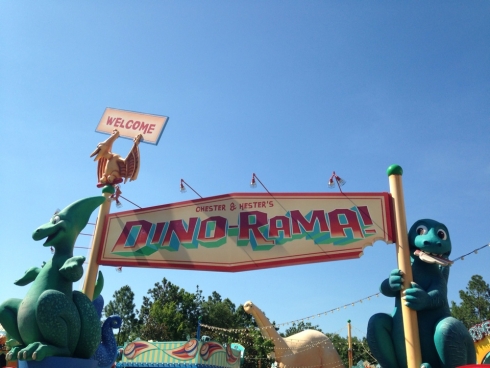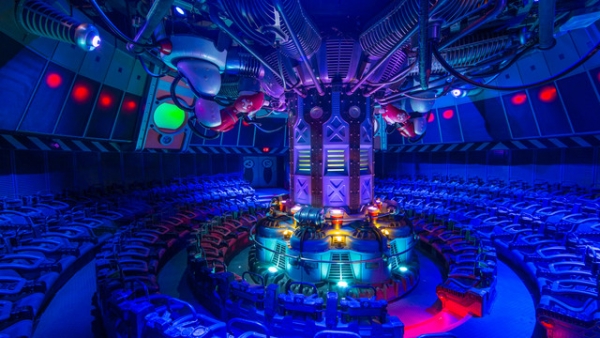3. You will be a tourist

What are you on Space Mountain? Or Splash Mountain? Or the Tower of Terror? What is your role in these attractions? Ultimately, it's up to you to decide. Maybe you're just taking your daily commute home from Alpha Centauri. Maybe you're just watching a story unfold while avoiding thorns in a briar patch. Maybe you're a hotel guest in the 1920s, or 1950s, or today. Those are decisions you get to make, and those decisions affect how you experience an attraction.
But, sometimes, a ride's designers make that decision for you – you are told, explicitly, that you are a tourist. You are you. No magic. No mystery. Just you.
The whole point of theme park storytelling is to transport guests into a different world – to show them something they couldn't see in real life, not to reinforce their role as a passive observer.
Now, yes, there are some very good attractions that do this – The Amazing Adventures of Spider-Man and MuppetVision 3D being among the best – but, on the whole, it's not a good sign.
The most obvious place where this concept fails is in Chester and Hester's Dinorama at Disney's Animal Kingdom. Designed to mimic roadside tourist traps along Route 66, these attractions provide little by way of theming and have no real aesthetic value. While rides like Kilimanjaro Safaris try to make guests feel like they've been transported to the African savanna, the Dinorama attractions are designed to make you feel like you're at a tourist trap. And, unfortunately, they succeed. Being told you're a tourist, usually with some disdain, is inauspicious for an attraction's quality.
4. There will be ironic “jokes”
Image: Disney
One of playwright Bertolt Brecht's great contributions to the world of theater is something called “alienation effect." According to Brecht, an audience that was emotionally engrossed in a play would only perceive it as a generic form of entertainment, and would fail to get any social or political message inherent in the text. And so, Brecht devised techniques that would distance the audience from the emotional aspects of the play in order to let them engage their analytical minds with the social overtones. So, for example, a character in a Brecht play might directly address the audience, thereby reminding them that what they're seeing is a play, which allows for more political thought and discourse.
Why do I bring this up? Well, for some reason, many of Disney and Universal's bad attractions employ these same type of distancing techniques. But, while Brecht was doing it to convey a political message, it's unclear why a theme park would want to do the same. Instead, they seemingly do it to be clever – however, the result is simply that it makes those attractions hard to care about.
Not to pick on Stitch's Great Escape again, but when it names a character Sgt. C4703BK2704-90210, calling to mind the TV show Beverly Hills 90210, it clearly shows that imagineers were trying to get members of the audience to disengage with the show's central story. This happens on other rides and shows as well – perhaps most memorably on the Enchanted Tiki Room (Under New Management), when Iago would interrupt the traditional Tiki Room show in order to tell the audience how boring it was. And, famously, Superstar Limo out at Disney's California Adventure featured nothing but pop-culture jokes that were immediately dated – drawing guests' attention to how bad the jokes were, rather than anything particularly evocative about the ride itself.
Now, ironic jokes and snark aren't always the sign of a bad attraction – MuppetVision 3D is essentially a hilarious Vaudeville comedy act (and Vaudeville heavily drew on the work of Brecht, interestingly enough) – but when combined with all these other facets, you end up getting a lesser attraction.
5. You will be told you are deficient
Epcot's Journey into YOUR Imagination, which operated for a short time from 1999-2001, is in the conversation for worst Disney attractions ever – largely because it featured everything on this list. But, particularly, that ride was bad because it told you that your imagination was terrible.
That was how the ride began – your brain was “scanned,” and you were quickly informed by an ex-Monty Python performer that you simply lacked the capacity for imagination. But, have no fear, he was there to fix it.
It's one thing to create a ride that fails to transport guests to an exciting new place. It's one thing to tell guests that they are, essentially, themselves for the duration of a ride. It's a whole other thing to set that expectation, and then insult them in the process. Do you want to know why this ride was a failure? It's really rather simple – people don't like being insulted, particularly when they paid nearly $100 to have the privilege.
Ultimately, these aren't hard and fast rules. Excellent rides can and do employ these concepts, and they often do so successfully, using them to take a good ride and make it great. However, they can also be used lazily in order to try and make an otherwise bad ride make sense, seem funnier, or have more of a purpose. So, if there are any theme park designers out there reading this, allow me to offer a bit of helpful advice:
Stay away from the 90210 jokes.


Comments
I went to Epcot last year and rode the updated version of the ride. I wasn't there during the 1999-2001 operation but after watching the video, the new one is much better. However, I could do without Figment and the songs.
You are a very small minority. The lack of Figment was the chief complaint and the outcry forced an immediate revision. Long live Figment and his catchy little tune!